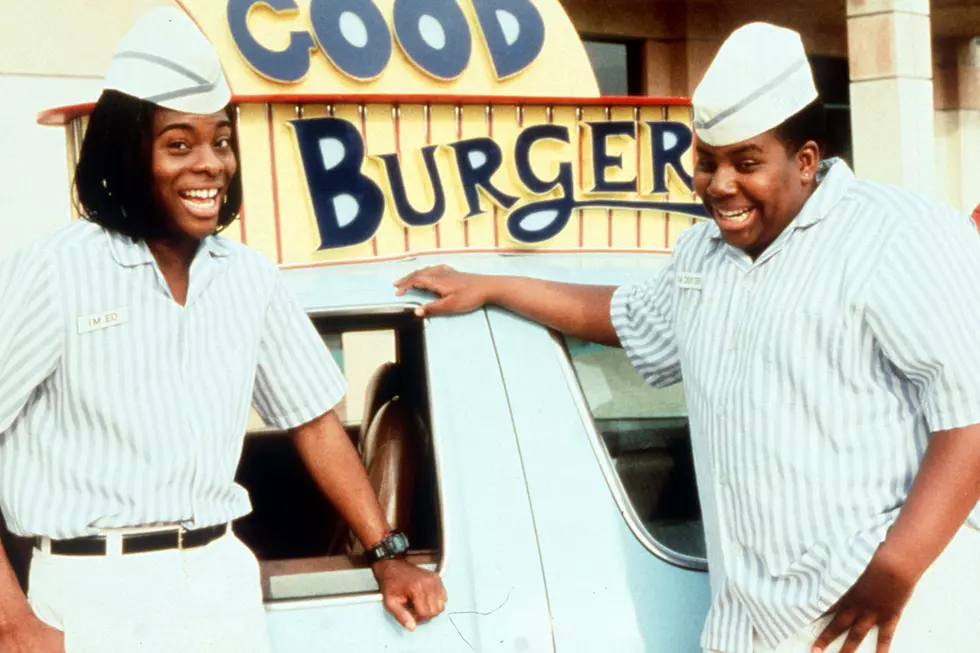
‘The Legend of Korra’ Finale Review: “Day of the Colossus / The Last Stand”
‘The Legend of Korra’ began as a “What if?”: What would the ancient-skewing world previously depicted in ‘Avatar: The Last Airbender’ look like 70 years in the future, with a female protagonist, with the traditional hero’s journey thrown out the window? The original plan was for a mini-series—a graphic noir tale that dipped its toe into recognizable class wars. But what ‘Korra’ could do, become, say, wound up overflowing into three more seasons. The potential creators Michael Dante DiMartino and Bryan Konietzko saw in their new incarnation crescendos into the show’s very last beats.
“Day of the Colossus” is 22-minutes of set-piece wizardry, featuring some of the most imaginative, heart-pounding action I’ve ever seen (a bar previously set by other ‘Legend of Korra’ episodes, if I’m being honest); “The Last Stand” continues the mayhem on a smaller scale, with contemplative fight sequences that blossom into thematic understanding. Villains are understood, heroes stand back up with confidence, and relationships, built brick-by-brick over 52 episodes, pay off and solidify. The series’ final image, Korra and Asami walking hand and hand into a newly created portal, looking into each other’s eyes with emotion beyond friendship, then drifting into the unknown, will burn brightly in my memory forever. The idea that two characters—shipped to death by the Tumblr devotees—do have a deep love is one last bold move for ‘Legend of Korra,’ a show that made bold moves at every opportunity.
Entrenched in Republic City, Team Avatar’s showdown against gundam-enhanced Kuvira builds like ‘The Avengers.’ Everything is in motion, each 30-second stretch a new splash page, spotlighting characters and bending maneuvers. After surviving an attack on the hummingbird factory, Bolin pulls a Superman, lifting a crumbling wall long enough to free his friends. They look up to find Kuvira’s war machine on the move. The towering mech acts like an oversized ‘Terminator’ robot, plowing through buildings and wading through water in its steadfast commitment to destruction. Nothing can knock it over. Later in the episode when they do get the upper-hand, it stands back up. Worse, Kuvira’s perfectly willing to blast away any potential threats. Or non-threatening cityscapes in need of face lifts. In one shot, a spirit vine blast turns the metropolitan horizon behind a gasping Korra into an explosive curtain. All is forgiven for the clip show episode—this finale goes all out. Heck, Korra scrapes her way down the building Hulk style. It really does match anything on the live-action scale.
For everyone who yelped “Why don’t the metalbenders just rip the thing apart?” when ‘Korra’ revealed its big (big) bad last week, Konietzko and DiMartino have a Comic Book Guy answer (courtesy of the not-so-Comic-Book-Guy Lin). The whole machine is platinum, all the way down to its joints. The good guys try their best to trip up Kuvira, though sabotaging doesn’t come easy, amplifying the terror with each failure. Meelo leads Operation Little Rascals, bombing Kuvira’s windshield with purple paint. The mech cleans it off with hidden washers—Kuvira thinks of everything!—but it’s only one of the many pranks befalling the metal titan. Bolin melts the ground below its feet with lava, Lin and Korra fly in with metal spools to wrap up its legs, and everyone pesters with their given bending powers. In a particularly satisfying shot, Kuvira brushes away soaring airbenders, buzzing about her mechanical face like a swarm of gnats. The dash of comedy anthropomorphizes her exoskeleton. When Team Avatar finally rip inside, it feels like they’re tearing at the dictator herself.
The double-feature finale’s continuous urgency makes the season’s careful pacing more evident. Even when it’s wrapping up long-standing friction, the episodes never let their characters take a breather. Asami’s big moment with her father Hiroshi is the least satisfying bit of knot-tying—something about “I love you” and plasma saws don’t mix—but leave it to Konietzko and DiMartino to find the perfect character to kill off. Not too central, omnipresent in Asami’s psyche, the ‘Korra’ writers sacrificed a slow-build revival of the Book 1 character for maximum punch at the end. The moment where Kuvira squashes Hiroshi, totally silly, still takes the wind out of you, thanks to a gut-wrenching shot of Asami propelling out of the hummingbird.
The union between Zhu Li and Varrick is a little sharper, a little more idiosyncratic, and undeniably sweet. Faked out while springing an EMP wave on Kuvira’s mech soldiers—causing them to domino effect in the finale’s only clunky, unintentionally GIF-able moment—Zhu Li finally gets her wish when Varrick pops the question amidst hummingbird roll out. Surprising her with a Kryptonite ring (worried about SuperBolin, Varrick?), the two provide some much needed lovey-dovey levity to spurts of mass destruction. Because Bataar Jr. certainly wasn’t going to revive his romance with Kuvira. Too busy amending things with Su, another extended resolution that says everything it needs to say and bails with grace. The next Beifong Family Thanksgiving will be a rough one, but they’ll make it.
Who would have imagined “Day of the Colossus / The Last Stand” as one of ‘Legend of Korra’’s musical highlights? Not since “Secret Tunnel” have we had such memorable ditties weaponized to annoy the hell out of non-‘Avatar’ fans. Maria Bamford nearly steals the show as Pema, who kills time for stranded Republic City citizens with old Airbender songs. And then Prince Wu shows up, belting heinous improvised showtunes. As badger moles earthbend tunnels for the evacuating bystanders, Wu jams. “If you don’t respect the broach. / You don’t respect meeeeee. / You’re no better than a roach.” Horrible. Beautiful. The diagetic musical numbers all add to Jeremy Zuckerman’s pulsating score, clacking as Lin and Bolin toppling over a cracked skyscraper, Korra freezing tidal waves of water around Kuvira’s legs, just to buy some time. The score is always moving, always swerving, and rarely resorting to common, drill-like minimalism. It’s lush and epic.
Expectations that “The Last Stand” would pause, navigate Korra and Kuvira back to a makeshift arena, and replicate their “Battle for Zao Fu” encounter, were dashed in the most exhilarating way possible. When Team Avatar breaks into the war machine, there’s no waiting for dramatic stars to align. They have a job to do. They move. Korra entering Kuvira’s bridge was a fury of the senses. Every time the Avatar hit with fire, air, or earth, Kuvira countered by sphering and flattening metallic shards. The warriors zip around the room like stunt bikes driving around the world, their locations pinpointed with mere frames. The sequence nears the point where it can’t be comprehended by brain. Nears, never passes.
Four seasons in, I went into the episode sure that no one I loved could die. And yet I still thought Mako was a goner when he throws his strength at the spirit vine power core. Another fight empowered by brotherly love (with one hell of a Nuktuk pound), it’s Mako and Bolin failing to shut down the battery that sent my heart rate flying. Fans have wondered over the seasons why we haven’t seen Mako lightning bend more. This is why. In this instance, Mako conjures an entire lifetime of energy that has swirled around him. I pictured him back in the factory from Book 1, a life before joining Team Avatar. And then I saw now, purpose. A beautiful display of power, the episode doesn’t go all the way to sacrifice Mako because he earned the rest of his life. Cable television could learn a thing or two from this arc.
When the spirit vine core erupts, the explosion throws quarreling Kuvira and Korra into the spirit vines for one more encounter, where the corrupt world leader finally has her Hayao Miyazaki moment. Though the spirits stick to their word of letting humans deal with human problems, “The Last Stand” still that trademark Miyazaki moment of going a step too far. Like killing the forest spirit in “Princess Mononoke,” Kuvira lets the entangled laser canon rip in a last ditch effort to obliterate Korra. I’ll never get tired/be less scare of the spirit BRONG noise. Korra manages to outrun it, even saving Kuvira when the weapon starts acting on its own. Korra’s ability to bend the spirit energy, find balance in both the physical and metaphysical worlds, saves their butts — while inciting an actual mushroom cloud in the process. For being a World War II heavy season, there wasn’t much historical connection in these final half hours. But this striking image of a “nuke” going off in the heart of Republic City should be clear to those who passed World History. In this case, our heroes outrun the blast and Korra sucks it back up into the Spirit Wilds, creating a glistening new portal in the process.
Settled in the Spirit World, Korra reaches the end of her philosophical journey. She channels Toph, showing Kuvira the common ground between them and the ideology that shifted her out of balance. Kuvira’s story of abandonment and anguish is a late card to play, and yet it fits the profile. There’s something behind every power-hungry leader, every villain. And it’s inside the Avatar too. “I understand what it’s like to be afraid,” Korra tells her adversary. Though the Great Uniter will never redeem herself in the eyes of the living, her own clarity makes her human. That’s the road to redemption.
Ah, a wedding. All it was missing was Prince Wu’s version of Yub Nub. ‘The Legend of Korra’ goes out with fireworks ... that dissipate out into quieter, sublime moments. Wu plans to abolish the monarcy in Ba Sing Se; Mako swears to Korra that he’ll always be by her side; Bolin is Bolin, forever; Tenzin watches his trainee become a master of every sphere; and then the final scene, an unexpected farewell with Asami. Perhaps underrepresented in this final Book, Asami has always glowed in Korra’s presence, imbuing the fragile Avatar with strength and stability. She’s an anchor, even off-screen. Their affection is deep, together hanging on for dear life as they grappled with militants, monsters, and men (of the awkward, romantic breed). In Book 3 they found each other. After Korra went away, the hearts grew fonder. And here, something beautiful walks into the horizon. Balance.
More From ScreenCrush









